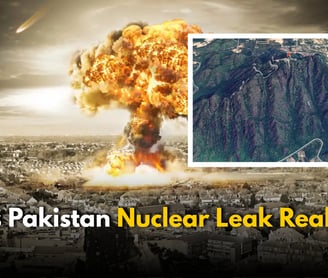The Kirana Hills Nuclear Leak Rumor: Unraveling Fact from Fiction in 2025
LATEST NEWS


On May 16, 2025, at 01:53 PM IST, the internet is buzzing with speculation about a possible nuclear leak in Kirana Hills, Pakistan—a region long associated with the country’s secretive nuclear program. The rumor gained traction following India’s Operation Sindoor airstrikes near Sargodha, just 20 km from Kirana Hills, prompting widespread debate: Did a nuclear incident really occur, or is this a case of misinformation spiraling out of control? Let’s dive into the origins of this rumor, the evidence (or lack thereof), and what it reveals about the fragile geopolitical landscape of South Asia.
The Spark: Operation Sindoor and Kirana Hills
The controversy began when India launched Operation Sindoor, a series of precision airstrikes targeting military installations near Sargodha, Pakistan, in response to escalating tensions. The operation, which involved advanced munitions like the BrahMos missile, successfully hit key targets, including the Sargodha airbase. However, Kirana Hills—a rugged, remote area historically linked to Pakistan’s nuclear ambitions—became the focal point of speculation. Known for its subcritical nuclear tests in the 1980s and rumored underground storage tunnels, the site’s proximity to the strike zone (just 20 km away) raised eyebrows.
Social media platforms, particularly X, exploded with unverified claims: a US B350 AMS aircraft, typically used for radiation detection, was spotted over Pakistan; an Egyptian plane allegedly delivered boron (a material used to suppress radioactive emissions); and hospitals in the region were reportedly overwhelmed with radiation-related cases. These claims fueled fears of a nuclear leak, with some users suggesting that India’s strikes might have inadvertently damaged a nuclear storage facility.
Official Denials: No Leak, Says the IAEA and Both Nations
The International Atomic Energy Agency (IAEA) swiftly responded on May 15, 2025, stating there was “no radiation leak or release from any nuclear facility in Pakistan.” Indian Air Marshal A.K. Bharti, overseeing Operation Sindoor, clarified that the strikes targeted military assets, not nuclear sites, and dismissed the Kirana Hills rumor as baseless. Pakistan’s military, through DG ISPR Sharif Ahmed Chaudhary, echoed this, denying any damage to nuclear infrastructure and labeling the rumors as “propaganda.”
Despite these assurances, the lack of transparency in both nations’ nuclear programs left room for doubt. Kirana Hills’ history as a nuclear testing site—confirmed by declassified US intelligence reports from the 1980s—made the rumors plausible to some. The deployment of a B350 AMS aircraft, even if operated by Pakistan’s Army Aviation (which acquired the plane in 2010), suggested internal concern, possibly about the stability of aging nuclear infrastructure near the strike zone.
The Evidence: What We Know and What We Don’t
Let’s break down the key claims driving the rumor:
The B350 AMS Aircraft: Posts on X highlighted the presence of a radiation-detection aircraft over Pakistan. While this initially seemed alarming, the aircraft’s ownership by Pakistan’s Army Aviation suggests it may have been a precautionary measure rather than evidence of a leak. No official radiation readings have been released to confirm any anomaly.
The Egyptian Boron Plane: Rumors of an Egyptian plane delivering boron to Pakistan remain unsubstantiated. Boron is indeed used to control radioactive emissions, but no credible sources—such as flight logs or government statements—support this claim. It’s likely a fabrication or exaggeration.
Hospital Overload and Radiation Spread: Some X users claimed hospitals near Sargodha were overwhelmed with radiation-related cases. However, no medical reports, news articles, or official statements corroborate this. In contrast, other users pointed out the absence of radiation on detection maps, undermining the leak theory.
Seismic and Satellite Data: A nuclear incident, even a minor one, would likely produce detectable seismic activity or visible fallout on satellite imagery. As of May 16, 2025, no such data has surfaced, further weakening the rumor’s credibility.
The Bigger Picture: Geopolitics and Misinformation
The Kirana Hills rumor highlights the volatile intersection of geopolitics and misinformation in South Asia. India and Pakistan, both nuclear-armed states, have a history of mistrust, and their opacity around nuclear programs fuels speculation. The use of bunker-busting munitions like the BrahMos in Operation Sindoor raises a theoretical risk: could a strike near a nuclear site, even if not directly targeted, compromise underground facilities? Experts argue that nuclear weapons have robust failsafe mechanisms, making a catastrophic explosion unlikely. However, a localized radiation leak from damaged storage units isn’t entirely implausible, especially if infrastructure is old or poorly maintained.
On the flip side, the rumor may serve a strategic purpose. Some X users suggested Pakistan could be amplifying the narrative to garner international sympathy or financial aid, a tactic seen in past conflicts. India, meanwhile, has a vested interest in downplaying any nuclear fallout—literal or figurative—to avoid global backlash. The lack of independent verification, such as on-the-ground reporting or third-party radiation monitoring, leaves the public caught between competing narratives.
What’s Next: Should We Be Worried?
As of now, the evidence leans heavily against a nuclear leak in Kirana Hills. Official denials from the IAEA, India, and Pakistan, combined with the absence of seismic, medical, or radiological data, suggest the rumor is more fiction than fact. However, the incident underscores the precarious nature of nuclear security in a conflict zone. Even a small, contained incident could have far-reaching consequences, from environmental contamination to diplomatic fallout.
For now, the international community should press for greater transparency from both nations. Independent monitoring by organizations like the IAEA could help verify the safety of nuclear sites near conflict zones. Meanwhile, the public must approach such rumors with skepticism, cross-checking claims against credible sources rather than relying on unverified social media posts.
The Kirana Hills saga is a stark reminder of the stakes in South Asia—a region where nuclear capabilities, military tensions, and misinformation can collide with unpredictable results. As the dust settles from Operation Sindoor, one thing is clear: in the absence of hard evidence, the truth remains as elusive as ever.